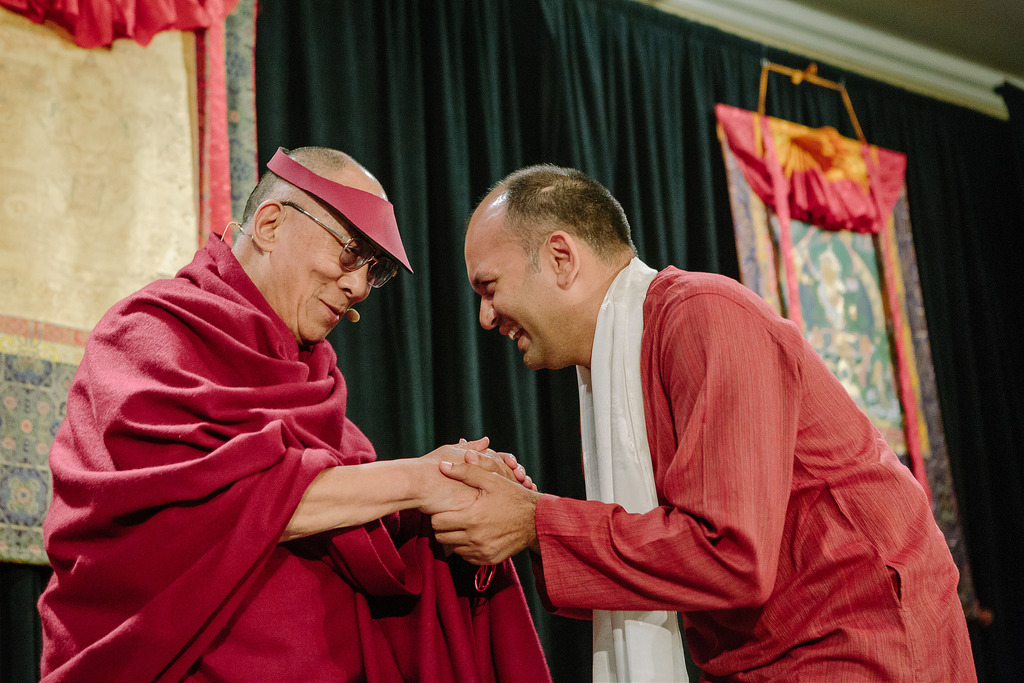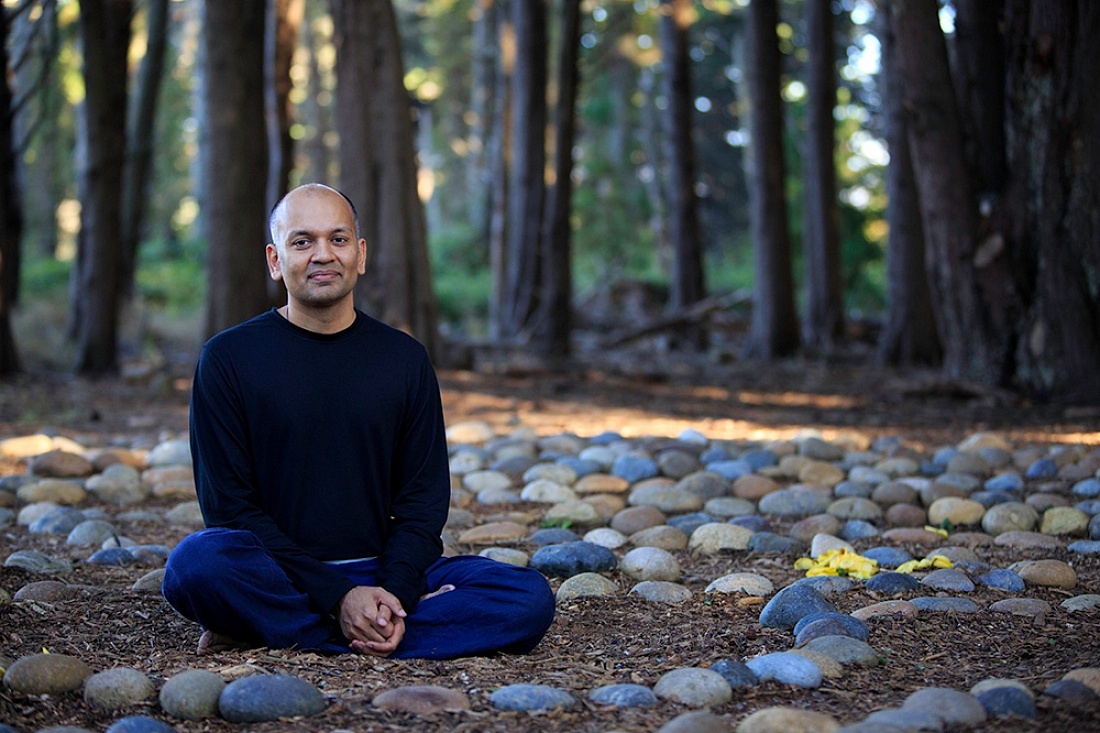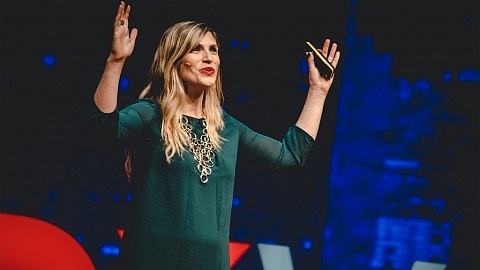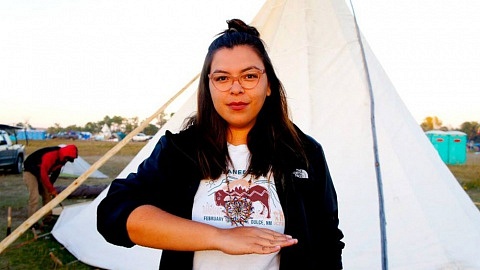It was in the early 90s, when Nipun Mehta stood before a decision: to either become a tennis pro or a Himalayan Yogi. He decided for neither and became a software developer at Sun Microsystems. In the late 90s, in the midst of the dot com era, he felt dissatisfied with the greed in his surrounding and went to a homeless shelter with three friends to give with no strings attached. This moment should become life changing for the young man in his mid-twenties. After creating a website for the homeless shelter, the joy of giving led him to start an organization called ServiceSpace, an incubator for gift economy projects. Since then, Nipun and his organization not only built thousands of websites for free, they also started several projects that developed into international movements, like Karma Kitchen, a pop-up-restaurant run by volunteers where the bill is always zero and people pay for their successors.
Nipun has received many awards, among them the Dalai Lama unsung hero of compassion award. Today, he gives lectures and speeches around the globe and spreads the message of »giftivism«.
What’s your personal background?
Ever since I was a kid, I would always ask the big questions of life. What’s the purpose of this whole charade? What happens after you die? What is the motive for action? Often, I didn’t find the answers I was looking for, so I would start investigating. Seventeen was a turning point of sorts in my life, when my spiritual search came into the foreground. I was playing a lot of tennis (secretly hoping to turn pro), I took a lot of advanced academic classes and was already a junior in college, and I was en route to a degree in Computer Science at UC Berkeley. My first (and only) job was as a software engineer at Sun Microsystems but my prime focus had shifted, somehow, to dealing with my unanswered existential questions. The journey still continues to this day, but where previously I was looking for answers, I now look to dissolve the questions.
Would you consider yourself an activist and if so, what are the tools you apply in your activism?
It depends on one’s definition of activist. If an activist is someone who tries to disrupt the status-quo to alleviate some suffering in the world, then definitely yes. But if an activist is someone who is angry with status-quo and the people who engage in it, then definitely no. I’m not motivated by anger, but I do think we can continue to innovate and upgrade our designs to improve our collective well being. You know, it took us 5 thousand years to put wheels on bags.  In that sense, I see activists as innovative entrepreneurs — but with two key distinctions.
In that sense, I see activists as innovative entrepreneurs — but with two key distinctions.
One is that instead of working in the confines of the monetary markets, they work in the commons of humanity. They know how to work with intrinsic motivations, not just carrot and stick models of extrinsic punishment and reward. They are sensitive enough to value multiple forms of capital, well beyond financial returns and tangible metrics. And they have the patience to work with a longer timeline, that sometimes can span many generations.
Second, and this is really the most important for me, is they understand how their inner transformation is connected to external impact. All too often, in our haste for changing the world, we forget to pay attention to what’s happening inside of us. As a result, we help others on the outside, but forget to be kind to those nearest to us. Burn out becomes common. Ultimately, in trying to build five bridges, we might just burn three others along the way. Social change giants like Gandhi taught us a much deeper way to serve: be the change you wish to see in the world. Anyone who serves in this way realizes just how difficult inner change is, and that alters how we engage in external service. As Rachel Naomi Remen says, when we help, we see life as weak; when we fix, we see life as whole; but it is only when we serve with an understanding of how that act is changing us, our service become an offering of humility and gratitude. Such acts create a rich ripple effect.
Now, that’s not the typical definition of an activist. So we invented a new word, for this kind of inside-out service — giftivism, where it’s not this versus that. It’s this *and* that. It’s about considering both the oppressor and the oppressed, in our field of love. That’s the real legacy of people like Gandhi and Mandela and Mother Teresa and Martin Luther King Jr.
In terms of tools, I think everything is at our disposal. The question is about being skilful, and using it in the right proportion. For instance, I’m a technologist from the Silicon Valley, so Internet is one of the biggest tools we use. We have millions of line of code that powers our work. But we don’t allow any ads in our networks or email, and we encourage using online networks to build offline networks. For someone like Facebook, this is a bad idea since you can no longer monetize engagement when you’re off the Internet, but we don’t design for monetization — so it creates very different patterns. All the upcoming tools like machine learning and AI will also pose similar challenges and require collective wisdom of finding the right balance. This is usually where society runs the risk of going off kilter, because we are so focused on narrow metrics and short-term impact, a giftivist’s toolkit and intention is much broader and could offer a great counter balance.
How did the transformation from working at a Silicon Valley computer company to founding an organisation with the aim of spreading generosity come about?
In my third year of college, I was offered a job at Sun Microsystems, working on the C++ compiler. Lots of PhD’s in my group, and I got few promotion in a very short period of time. This is the late 90s, so the dot-com boom just started and my peers were all starting their own companies, and greed was very much in the air. It felt like flaunting their fancy cars, big dreams, and their own startup. Some of it was exciting, but lot of it didn’t land with me. So I wondered if we can do something to channel that creativity, enthusiasm and energy of the Valley into a different direction. Gordon Gekko famously told us that “Greed is good”, but our hypothesis was that generosity is better. So we started with four friends, building a website for a homeless shelter. The thought was, “We can’t do what you’re doing, but perhaps we can amplify your capacity in this small way.” Website building was great, and got us a lot of attention in those days, but what was even more remarkable was generosity itself. It was transformative, and regenerative. The more we gave, the more we wanted to give. Not just for me, but for everyone. And rather quickly, ServiceSpace went from 4 volunteers to 40 to 400 to 4 thousand to 40 thousand, and now well over 400 thousand. It’s really a testimony to the power of love.
In 2005 you went on a pilgrimage with your wife. Can you tell me what it was all about?
Six months into our marriage, my wife and I dropped all our plans, went to the Gandhi Ashram in India and decided to embark on a walk. We had no plans and no end date. Humanity poorest billion live on dollar a day, so we decided that’s what we’d have between us. We would serve wherever an opportunity showed up — from pushing stalled cars on the highways to helping old farmers carry loads to cleaning community places to sharing stories of everyday heroes. We ate whatever food was offered, and slept wherever placed was provided. Sometimes things didn’t work, and that gave us an opportunity to grow in renunciation; sometimes things worked out miraculously, and that gave us a chance to cultivate gratitude. After about 1000 kilometers, we ended up at a monastery and flipped a coin to see if the pilgrimage would continue internally or externally — we ended up staying, and doing meditation retreats over the next three months. “Just jump and the net will appear,” they say. That was our experience. It’s scary to jump and trust like that, but when we did, we happily discovered a net of compassion and interconnection that we were previously blinded to.
What was the most touching experience you had on your pilgrimage?
On our walking pilgrimage, we noticed that those who had the least were most readily equipped to honor the priceless. In urban cities, the people we encountered began with an unspoken wariness: “Why are you doing this? What do you want from me?” In the countryside, on the other hand, villagers almost always met us with an open-hearted curiosity launching straight in with: “Hey buddy, you don’t look local. What’s your story?” In the villages, your worth wasn’t assessed by your business card, professional network or your salary. That innate simplicity allowed them to love life and cherish all its connections.
Extremely poor villagers, who couldn’t even afford their own meals, would often borrow food from their neighbors to feed us. When we tried to refuse, they would simply explain: “To us, the guest is God. This is our offering to the divine in you that connects us to each other.” Now, how could one refuse that? Street vendors often gifted us vegetables; in a very touching moment, an armless fruit-seller once insisted on giving us a slice of watermelon. Everyone, no matter how old, would be overjoyed to give us directions, even when they weren’t fully sure of them.  And I still remember the woman who generously gave us water when we were extremely thirsty — only to later discover that she had to walk 10 kilometers at 4AM to get that one bucket of water. These people knew how to give, not because they had a lot, but because they knew how to love life. They didn’t need any credit or assurance that you would ever return to pay them back. Rather, they just trusted in the pay-it-forward circle of giving.
And I still remember the woman who generously gave us water when we were extremely thirsty — only to later discover that she had to walk 10 kilometers at 4AM to get that one bucket of water. These people knew how to give, not because they had a lot, but because they knew how to love life. They didn’t need any credit or assurance that you would ever return to pay them back. Rather, they just trusted in the pay-it-forward circle of giving.

Nipun Mehta receiving the »Dalai Lama Unsung Hero of Compassion« award.
You then started Karma Kitchen. What is it all about?
Karma Kitchen is a pop-up, gift-economy restaurant. Like any other restaurant, you walk in and have a meal but here, your bill reads zero. It’s zero because someone before you paid for your meal, and you have a chance to pay forward for someone after you. Most people think that you can’t trust people like that, because people are fundamentally selfish. To be frank, even we didn’t know how long it would last. So that was our experiment. It turns out, that if you build a strong context, people respond to generosity with even greater generosity. Tens of thousands people were fed, and the chain is still going — and in fact, it has spread to more 23 locations around the globe! It even inspired seminal research at UC Berkeley, which was aptly titled, Paying More When Paying For Others.
Of course, this need not just to limited to a restaurant context. Much in the same way, we run a rickshaw in Ahmedabad, an art magazine in the US, and so much more. Such a “gift economy” model that cultivates a shift from transaction to trust can be applied in umpteen ways, and is much needed in our culture today.
What do you think is the reason, that people in western societies ended up with such a self-centered way of life?
Today’s culture favors individual merits over collective intelligence, immediate gratification over equanimity, personal grit over unearned grace. Invariably that me-centered approach is going to disconnect us — systemically, socially, and spiritually. We are seeing ripples of that gap across the board. We desperately need to reconnect, and generosity is such an elegant and accessible lever to bridge that chasm towards a we-centered life and society. The small act of kindness reconnects us, first and foremost, to ourselves; by its very nature, it reconnects us to the other; and in a matrix of such nodes of trust, it allows very different systemic designs to emerge. So what seems like a simple thing, a little act of service, is a rather revolutionary act in today’s era of disconnection.
Apart from the “Survival of the Fittest” approach of Darwin, one can also find an approach of survival of the kindest in his mostly unknown publication “The Descent of Man, and Selection In Relation to Sex”. Do you integrate scientific research into the development of your projects? Which theories are most important to you and why?
When I’m talking to school kids, I will often ask them, “Do you think we are fundamentally compassionate beings who sometimes have selfish experiences, or are we fundamentally selfish beings who sometimes have compassionate moments?” It’s usually 50-50. But science is quite clear that we’re actually innately compassionate, that the untold story of evolution has indeed been about “survival of the kindest”. During World War II, for instance, an army general found that more than 80% of the troops intentionally misfired, simply because we aren’t wired to kill! His findings have been corroborated by many other studies. Of course, it’s a sad tale that we have now built sophisticated methods to numb our innate nature, but there is overwhelming science that tells us that we are wired to care, wired to be connected to each other. Even before we learn words and concepts, toddlers already have a propensity towards generosity.
In a thousand ways, neuroscience has opened up radically new conversations as we see just how deeply we are connected to each other. Dacher Keltner has probably done the most comprehensive work on this. Mindfulness, similarly, has seen a massive explosion of compelling research that one of our friends in the UK, Jamie Bristow, got the whole UK parliament to meditate! Robert Emmons has done some ground-breaking work on the science of gratitude. In one study on awe, Paul Piff showed that looking at a tree — instead of a building — for just 30 seconds, made people behave more pro-socially. Just a simple smile release incredible hormones in our body.
So, really, there is no shortage of science around well being. But, as a culture, we have been painfully slow in adopting these insights into our systems.
In ServiceSpace, we are constantly looking at new research and cultural trends. For instance, we see across many studies that behavior change doesn’t happen by individual will alone. That repeated practice and community is a huge factor. So on KindSpring.org, we created a 21-day challenge platform across many different themes like kindness and gratitude and mindfulness, that you would engage with your community. And moreover, our entire basis of being volunteer-run, is a testimony to power of intrinsic motivation — which Edward Deci and many other scientists have repeatedly shown to far more powerful than extrinsic motivations like money. [More in: Making Gratitude Viral]
Service Space has several projects with a pay-it-forward approach running. Can you explain how the pay-it-forward mechanism works in the cases of Smile Cards and Karma Kitchen? Why do these models leave something in people’s brains and hearts?
Pay it forward idea is fundamentally rooted in gratitude. When we engage in a transaction, we engage in direct reciprocity. Me and you. It’s very narrow. A gift economy, on the other hand, invites us into a much broader engagement of indirect reciprocity. Someone who came before me has paid for me, and I hold gratitude for that. Then I pay forward for people after me, who will never be able to say thank-you to me. It’s not tit-for-tat at an individual level, in that I might give more or receive more than what I put in, but all together, it affords us a circle. And the beauty of the circle is that it is greater than the sum of its parts. So by letting go direct reciprocity, we birth an entire new realm of possibility. It’s rooted in a shift from me to we. [More in: Three Stages of Generosity]
At a practical level, the way something like Karma Kitchen works is this — we rent the restaurant for X amount of money. Then we take over the restaurant, from its ambiance to its processes. Our aim is to build a strong context of love. Volunteers do everything from serving food to busing tables. When guest come in, they have their food just like they would at a regular restaurant, but at the end of their meal, the check reads zero. They can pay forward whatever they are moved to offer. At the end of the day, we add it all up and pay for next Karma Kitchen’s rent. Sometimes, we have a deficit, but on average, there’s always a surplus and the chain keeps going.
Similarly, with Smile Cards, we ship them out as a gift to anyone who wants them. People will do an anonymous act of kindness for someone, and leave a Smile Card behind which tells the recipient that they don’t know who did this, but they can pay it forward and make someone else’s day like that. Because giving is such an intrinsically rewarding experience, people are typically moved to make a financial offering even when it is unsolicited. Using this gift-economy model, we’ve put millions of Smile Cards in circulation. It works, because generosity works. Any act of kindness make us feel great, and more often than not, we will want to pay it forward and return to our innate state of connection with others. It’s just human, and our model of operation counts on that.
Where else can this model be applied?
Ultimately, this can be applied wherever there is a transaction. And that’s everywhere.
Practically speaking, though, it is easier to pilot this idea in a context where subjective value matters, where marginal costs are low, and volunteer labor can be easily integrated. If Karma Kitchen was a buffet instead of a full-service restaurant, it wouldn’t work as effectively because you are stripping out the possibility of subjective value of the interaction between a volunteer and a guest. We run a print magazine, works & conversations, in this way but that’s probably not going to be as effective with your Lexus car dealership because your fixed costs are so high. Similarly, this works really well for all kinds of services, like our gift-economy rickshaw or a gift-economy health clinic, because the premium is on the service.
All in all, the key to making this work is context. Just as quid-pro-quo transaction is very narrow, context driven design is very broad. Generosity never fails, but the question really is — can we create a strong enough context for people to feel and then respond to generosity? It’s always possible to turn any transaction into an expansive experience of compassion, but we need to shift our orientation to tap into this. It takes a fair amount of inner growth to become a black-belt in regenerative generosity.  In fact, we started Laddership Circles as peer-learning virtual circles to help support this kind of growth.
In fact, we started Laddership Circles as peer-learning virtual circles to help support this kind of growth.
You use the term Gandhi 3.0. Can you give us an overview of what is meant by that term?
In the times of Gandhi, social action organized in a one-to-many formation. One Gandhi and many of us. His successor in India, Vinoba Bhave, came along and built a stronger network by walking across India and cultivating one-to-one connections. Along the way, he also pointed to what was emerging: “What rises up like a fountain, will return in the form of many distributed drops.” That’s exactly what we’re seeing now. We call it Gandhi 3.0, where Gandhi stands for the age-old principle of leading with inner transformation and 3.0 represents the many-to-many networks that are popularized by the modern-day Internet. In a sense, it’s a bridge from the Internet to the Inner-Net. It’s a journey of building distributed and decentralized movements that lead with inner transformation, of leveraging technology to nurture generosity, of cultivating practices that encourage “being the change”, and ultimately of putting priceless gifts — like empathy, trust and compassion — into greater circulation.
What is the main transformation that people need to aim for to change their lives?
I would identify four key shifts. First would be consumption to contribution; can we open each door and ask, “What can I give” in place of asking “What am I going to get?” Second is a shift from transaction to trust; can we move from direct reciprocity to indirect reciprocity, that affords us the circle? That leads to a fourth shift from isolation to community; can we learn to hold multi-dimensional relationships with tolerance, in place of seemingly comfortable echo-chambers? And lastly, scarcity to abundance. We’ve created this implicit equation of wealth equal money, when, in fact, there are multiple forms of wealth. Can we create value in the world, even if it doesn’t advance the GDP?
You even question Maslow’s pyramid… What’s your approach?
Maslow’s hierarchy of needs refers to a linear progression from material to emotional to spiritual well-being. We’ve just seen it rendered false across the board, and Maslow himself changed his mind. When Victor Frankl narrated stories from concentration camps, about how “basic needs” were not met but it was “higher needs” that increased their chance of survival, Maslow admitted, “Frankl is right.” What social scientists are now using to frame this conversation is that our various are more like Vitamins. We don’t finish life’s entire need for Vitamin C before we get to Vitamin D. We need it in balance. So yes, we have to pay attention to the basic needs, but Vitamin G(enerosity) is not a luxury sport. It’s not something you arrive at when you retire. You need it now, no matter who you are and where you are planted.
Why do you think is it, that the idea of connection is approached so much when it comes to making profits and starting protest movements, but not when it comes to spreading love and generosity?
Prior to the Internet, we often heard this phrase, “strength of loose ties.” But what modern day social networks have done is turned everything into a loose tie. We optimized for the quantity of connection, and forgot about the quality. That has disconnected us altogether. People nowadays have very few deep friendships, and that’s creating all kinds of unexpected problems in society. If 50 of us are watching TV, we just 50 connections; if 50 of us had phones and talk to each other, we would have 1225 connections; but if 50 of were on group-forming network like Whatsapp, we have the potential of 100 million trillion connections. This is what a “many to many” network is all about.
For the past 15-20 years, we’ve seen the power of this play itself out in the world of profit, and to a smaller degree, in the world of protest. But we have hardly seen this applied to the possibilities of compassion. CNN’s of the world lead with bad news, not good news, because it gets you more eyeballs. There is no dot-com around kindness. No one is trying to increase trust in society with artificial intelligence algorithms. Part of the reason is because the only lever for organization we are familiar with is commercial — hierarchies operating with carrot and stick incentives, for short-term results. That may work well for certain things in society, but not everything. We owe it to ourselves to keep an entire spectrum of organizing alive, and to do that we need the younger generation to be equipped with not just “leadership” skills but also what we call “laddership” skills.
Your approach is very much focused around the individual. Some of the biggest challenges need systemic change. Do you think individual generosity, even in networks, are the basis for the change it needs to save the planet and make it a more social world for everyone?
Oh, I’m all for systemic change. During Obama’s presidency, I served on his advisory board for addressing poverty and inequality, and we argued for a shift from transaction to relationship. There are very many concrete things that can be done to address this. Separately, I was part of a global group for deepening the conversation around well-being, where we spoke with the prime minister of Bhutan who implemented Gross National Happiness, and with president of Costa Rica which had abandoned it’s army since late 40s, and Ecuador’s leadership where they have given rights to rivers and trees. I also sit on the board of Greater Good Science Center, whose upcoming project is about bringing science-backed empathy exhibits into major museums around the United States. Just last week in London, I spoke to 500 investment bankers about ethical considerations in the realm of technology.
At a macro level, society has three major spheres — private sector, public sector and the voluntary sector. In theory, public sector is supposed to balance out the private and public sectors, but in reality what’s happened is the private sector of gobbling up the public and also voluntary sector (as most recently witnessed with the sharing economy bubble). If we want to create change, in today’s context, we are required to be subservient to the private sector. I’m not saying private sector is all bad, but it is far too narrow to be the king of the hill. Both private and public sector should actually be in service to the voluntary sector.
So that is the system that actually needs a change, a radical upending, a revolution. Sure other “systemic” changes may provide some short-term relief, but it’s not going to last unless we shift our core organizing principles. Internet is not the Internet without Net Neutrality. For that deep, seismic, cultural shift, I think individual generosity and transformation is place of highest leverage. If an individual gives, is held in a web of deep ties, has space for inner transformation to arise, it will create the foundation for rich, sustainable growth. That’s what ServiceSpace is committed to.
Do you think we need new idols?
We desperately need new idols, and new stories. Israeli professor, Yuval Noah Harari, articulate this concept of “inter-subjective” reality. There’s the objective and subjective realities, but what makes human beings unique is that we can cooperate at varying scales, and we do this through our manufactured narratives. Money is a story, Europe is a story, Google is a story. What makes it powerful is that it’s a shared story. Can we create a new story? And can we find heroes and sheroes who are courageously living into that new story? I think we must, if we are to create change.
What’s your strategy of spreading your messages to the world and scaling your projects internationally?
You know, when Mother Teresa was asked about her strategy for sustaining 400 centers around the world, she just said, “Well, I pray.” She never kept any cash reserves. In secular terms, I see that as a radical trust in emergence.
If you’ve built a strong field, with a rich matrix of interconnections, your job goes from “plan and execute” to “search and amplify”. In place of seeking and strategizing, you are focused on keeping the field in integrity with its organizing principles. And our principles are to: (a) be volunteer run; ie. driven purely by intrinsic motivations; (b) don’t fundraise; ie. unlock alternate forms of capital; (c) honor the small; ie. trust in the process and let outcomes take care of themselves. After 20 years of building such a field, with millions of inputs coming in every month across a myriad different doors, you can imagine just how many things are arising on a moment to moment basis. It’s mind blowing. I could’ve never predicted this, 20 years ago, and if I’m being really honest, I can’t even predict what’s going to happen in the next 2 years.
In that sense, my strategy is to trust in the core values. We have never pitched a story to the media, and yet received ample media coverage; we have never asked to speak at any place, and yet been in front of hundreds of thousands; we have never done any fundraising and yet have never felt a lack of financial capital. On paper, it might seem magical, but in practice, it’s just hard work — but in a particular way. First, I have to live into the values; to the degree that I can “be the change” is the degree to which I can see the emergence (and not have it in my blindspot); this requires an untiring mind. Then, I have to ensure that the entire ecosystem stays aligned with these values; this takes immense skillfulness when you don’t have any coercive power to use. And lastly, it invites you to “search and amplify” patterns of positive deviance; and one has to learn to “ladder” projects from the back of the room in place of leading from the front of the room.
So many people seem to be overwhelmed by the sheer number of issues we are facing as humanity. What do you tell people who ask you: “What can I do”?
Yeah, sometimes it can be overwhelming to see the suffering in the world. My wife knows this — I will sometimes just walk on the streets and notice a homeless person, and start crying. Or even just a waiter in a restaurant. You know, we want to share our love with everyone, don’t we? What helps me, though, is to remember the flashlight principle. If I’m at point A, and I shine my flash light at my destination, point Z, I won’t get anywhere. But I stay humble, focus on life in front of me, I would see point B, and then point C, and then bit by bit, realize that I’m progressing towards point Z. No matter what state the world is in, no matter what state we are in, the only thing we can do is serve in this moment.
So to anyone, and everyone, my first suggestion would be: do a small act of kindness, for life in front of you. Here and now. Surely, it will create an inexplicable external ripple effect, but it will create even more significant inner ripple effect. It will change the eyes through which you look at the world. And my second suggestion would be: support others doing acts of kindness. In supporting others, you will build a web of deep friendships — and that will give you resilience when the going gets tough.
If you could take 3 books to an island, which ones and why?
I’m not sure I would take books to an island.  But three significant books that I have deeply enjoyed: (a) Siddhartha, by Herman Hesse, for the reminder about the eternal pursuit of “Who am I?”, (b) One Straw Revolution, by Masanobu Fukuoka, for the design principles of permaculture, (c) Hind Swaraj, by Gandhi, for a vision of a society that leads with inner transformation.
But three significant books that I have deeply enjoyed: (a) Siddhartha, by Herman Hesse, for the reminder about the eternal pursuit of “Who am I?”, (b) One Straw Revolution, by Masanobu Fukuoka, for the design principles of permaculture, (c) Hind Swaraj, by Gandhi, for a vision of a society that leads with inner transformation.
Additional Information
Nipun’s talk at TEDxBerkeley gives a deep insight in his approach to project design in the context of giftivism:




